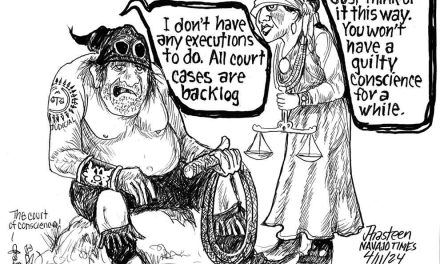
NM redistricting act signed – advocates say more needed
By Colleen Keane
Special to the Times
ALBUQUERQUE
On Tuesday, New Mexico Governor Michelle Lujan Grisham signed into law Senate Bill 304, legislation that changes the way New Mexico draws voting districts.
Sponsored by Sen. Brenna McKenna, D-Corrales, the redistricting act makes the process transparent by putting mapping responsibilities for state, congressional and commission seats in the hands of a seven-member diverse community committee.
Previously, lawmakers drew the maps, some say behind very closed doors.
“With the signing of this legislation by the governor today, New Mexicans will finally have a constitutional, fair, and transparent redistricting process,” McKenna stated in a press release from New Mexico House Democrats.
Former Supreme Court Chief Justice Ed Chavez in a phone call with the Times said, “(SB304) is a big leap ahead. The public will be clearly aware” and have a voice on how voting districts are mapped.
Under the new law, which goes into effect in July, there will be public hearings across the state, community input included in the voting boundaries and testimony recorded, indexed and documented.
“(The) citizens’ committee will make the difference,” Chavez said.
The work to open up voting districts included in great part the New Mexico Redistricting Committee Task Force, with about 25 members who focused on fair voting access.
‘A big win’
Chavez, Leonard Gorman, director or the Navajo Nation Human Rights Commission, Diné Sen. Shannon Pinto, D-McKinley-San Juan, and Ahtza Chavez, Diné, director of the NAVA Education project, added their voices as members.
“This is a big win!” said Ahtza Chavez.
But she added, “The bill is not strong enough. We (wanted) tribal boundaries to be considered.”
Earlier in the session, the redistricting task force drafted HB211 and SB199.
HB211 was sponsored by Rebecca Dow, Kelly Fajardo, Joy Garratt, Natalie Figueroa, and Acoma Pueblo’s Georgene Louis.
SB 199 was sponsored by Gerald Ortiz y Pino and Mark Moores.
The companion bills included a provision that allowed voting districts to be smaller than how the state normally divides them up, which in turn would allow consideration for Navajo chapter boundaries.
Districts are remapped every 10 years after the census is completed to take into consideration growth or loss of population. Each district across the state is supposed to have about the same number of voters.
“This doesn’t work in tribal communities,” said NAVA’s Chavez explaining that the smaller tribal populations don’t fit the standard, chiseled out voting districts usually carved up.
Gorman added, “New Mexico boundaries have a tendency not to respect Navajo chapter boundaries” that is “a very serious problem that we see from our office.”
Gorman has seen the impact of mainstream district mapping for many years.
Tribal members living within chapter boundaries are dispersed to polls many miles from their homes to cast their vote in federal, state, county, school board and for seats on the Public Regulatory Commission.
Gorman added that on days when tribal elections are held, dual Navajo/New Mexico citizens stand in line at two different polling locations, one at their chapters, the other many miles away.
To get to the polling locations off tribal lands, they face many obstacles, which impacts voter turnout.
“(Tribal members) may not have transportation or gas money and they may be faced with bad roads, along with snowy or muddy weather,” said Gorman.
A push for home voting
As a redistricting task force member, Gorman recommended a change in the voting process to break down barriers faced by dual tribal/state citizens.
The solution he advocated for is called “splitting” – allowing smaller populations in the redistricting process.
Then voters who live within chapter boundaries could vote in both tribal and mainstream elections in their own communities and won’t have to drive hundreds of miles, explained Ahtza Chavez.
Justice Chavez agreed SB304 is lacking.
“It’s not everything we (on the task force) wanted,” he said. “We need more voting locations (in New Mexico), so Native Americans don’t have to drive so far. (Voting) has to be more accessible.”
But the splitting provision wasn’t included in the successful SB304.
Nor was it included in SB15, sponsored by Brian Egolf and Mark Moores, another version of the redistricting bill.
While splitting districts to recognize chapter boundaries didn’t show up in SB304, Ahtza Chavez said other promising provisions were rolled in just as the clock was running out on the session.
She pointed out that SB304 has a provision which mandates that the newly created citizen committee will make every effort to consider political and geographic boundaries, including the boundaries of Indian nations, tribes and pueblos when drawing voting maps.
“We have language (in SB304) saying (the state) wants to pay attention to tribal chapter house boundaries,” she pointed out adding the bill “moves us closer to be able at some point split these districts.”
There’s also language in the bill that allows the public to incorporate suggested changes.
“If everyone on Navajo says we want split districts so we can vote where we live and not have to drive miles, we can move in that direction,” she said. “We will continue to advocate and educate.”
“We need to raise the issues,” Gorman said, “make them known, and (keep collecting) data. That is what we have to do to make our point.”
Information: navaeducationproject.org, nnhrc.navajo-nsn.gov, nmfirst.org, redistrictnm.org, nmlegis.gov








 Highway 264,
Highway 264, I-40, WB @ Winslow
I-40, WB @ Winslow